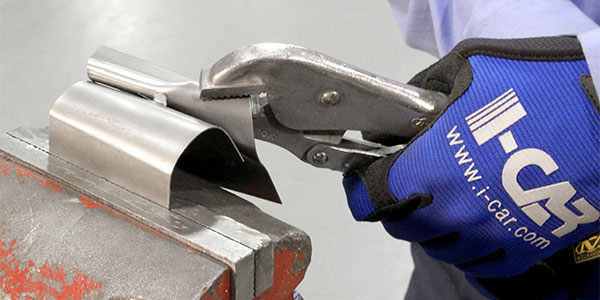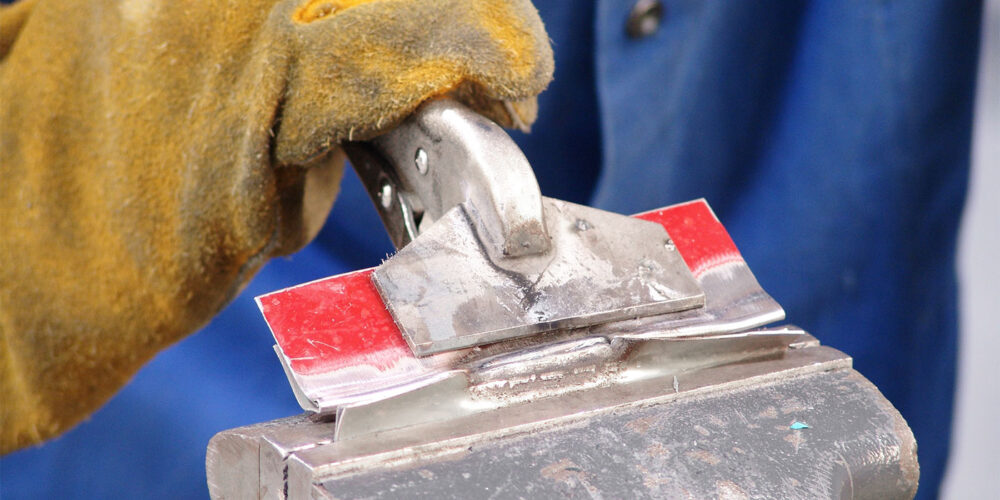In the collision repair industry, destructive weld testing stands as a crucial quality control procedure. This process carries significant weight, particularly for body shop managers and technicians, as it directly impacts the safety and structural integrity of repaired vehicles.

Up to Par
Destructive weld testing is all about ensuring that the weld settings and techniques are up to par before they’re applied to the vehicle. In essence, it serves as a test not only of the weld but also of the welder, encompassing all the elements involved. It’s a preemptive step, because once the welds are on the car, testing becomes impossible — except in unfortunate cases involving an accident. Essentially, this testing procedure creates a sample to assess how well the weld would hold up under the most extreme conditions.
Materials
To execute this process correctly, it’s vital to choose the appropriate substrate materials, which can vary from vehicle to vehicle and from one weld joint to another. Therefore, before making any repairs to the vehicle, it’s recommended to create samples using the parts removed from the car. These initial samples should be crafted from stock materials or coupons, as configuring the frame rail or welded panels for the test can be time-consuming and labor-intensive. Once you’re in the proximity of your desired welder settings, you can employ your sample material from the vehicle to perform the necessary destructive weld tests.
An Obligation
Conducting destructive weld testing before welding on a customer’s vehicle is a fundamental practice for body shops. It goes beyond mere quality control; it is an obligation to ensure the safety and well-being of the consumers who entrust their vehicles to repairers.

The average consumer may not fully comprehend the intricacies of vehicle repair and the critical role they play in restoring a vehicle to the vehicle maker’s standards. Our responsibility is to ensure that each vehicle performs as it should, not only to get back on the road but, more importantly, to ensure the safety of the driver and passengers.
Destructive weld testing provides us with a controlled environment to assess the quality of the welds, and it’s as close as we can get to crash-testing the car without endangering anyone. Destructive weld testing is a crucial component in upholding a commitment to safety and performing quality repairs.
Variables
Collision repairers should perform destructive weld tests before every welding operation. You never know what may change and influence the outcome, such as equipment, power supply, vehicle construction materials and the person welding. You can’t rely on what happened yesterday to be the same as today.
Procedures
Weld testing procedures can vary between manufacturers, with specific performance parameters in place. It is essential to consult the OEM repair procedures to find guidance on the proper testing methods.
For MIG welds, a reliable technique is the bend-and-break method, often using locking pliers. As another example, spot welds typically undergo a peel test or twist test to evaluate the weld integrity. These standardized testing methods ensure the welds meet the necessary standards and maintain the safety and structural integrity of the repaired vehicle.
Pass/Fail
Performing a destructive welding test is part of I-CAR’s Welding Training and Certification program — that’s how critical it is to the welding skill. Our team of welding instructors not only use destructive weld testing to determine if the welds performed were successful but also to find out if the technician performed the destructive weld test accurately and correctly determined the pass/fail of the weld tested. Generally, the material should break, not the weld. When the weld doesn’t break, that proves the weld is as strong or stronger than the base material.
Skill
The way a welder handles the job has a significant impact on the weld’s performance. This is a critical factor, especially in our Welding Training and Certification program. We often ask: What caused the change in how the weld performs? Was it the welder (the machine) or the welding process itself? Most of the time, it is the welder (technician) and his or her skills that play a vital role. Welding is a skill-intensive process, and even a slight change in technique can make a significant difference in the result. This highlights the importance of precision and expertise in achieving consistent and successful welds.
One often overlooked aspect is the need to thoroughly document your destructive weld tests. Consider capturing images and taking detailed notes, like a scientist recording all variables. By doing so, you’ll build a valuable reference library of past settings and techniques, supplementing the OEM repair procedures. This resource can speed up achieving a successful weld. For further insights, don’t hesitate to consult RTS (rts.i-car.com), and reach out to Ask I-CAR for support in the field too.
Welding Equipment
You must know the equipment is capable of performing the task. Can the welder perform the weld that is needed? Amps, for example, are something to consider when making that determination. Equipment is critical to the integrity of weld, and I-CAR outlines equipment requirements for our Welding Training and Certification because it’s important to ensure training and skill integrity. As part of I-CAR’s Vehicle and Technology Specific Training portfolio, we also offer various online courses that offer an overview of how to set up and use the specific equipment.
To watch an I-CAR Subject Matter Expert conduct a destructive weld test in the newest episode of “Just in Time,” a short-video series designed for technicians, click here.














